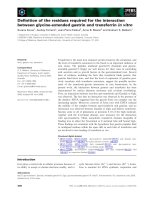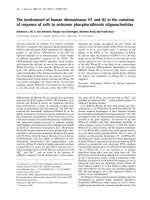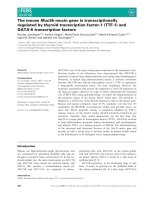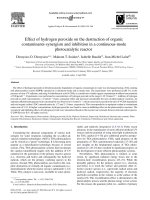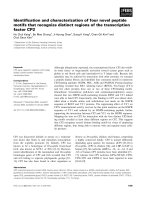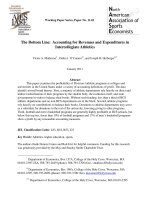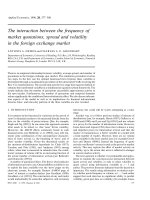The transcription factor FOXO4 is down-regulated and inhibits tumor proliferation and metastasis in gastric cancer
Bạn đang xem bản rút gọn của tài liệu. Xem và tải ngay bản đầy đủ của tài liệu tại đây (2.12 MB, 11 trang )
Su et al. BMC Cancer 2014, 14:378
/>
RESEARCH ARTICLE
Open Access
The transcription factor FOXO4 is down-regulated
and inhibits tumor proliferation and metastasis in
gastric cancer
Linna Su1†, Xiangqiang Liu1†, Na Chai2†, Lifen Lv1, Rui Wang1, Xiaosa Li1, Yongzhan Nie1, Yongquan Shi1*
and Daiming Fan1*
Abstract
Background: FOXO4, a member of the FOXO family of transcription factors, is currently the focus of intense study.
Its role and function in gastric cancer have not been fully elucidated. The present study was aimed to investigate
the expression profile of FOXO4 in gastric cancer and the effect of FOXO4 on cancer cell growth and metastasis.
Methods: Immunohistochemistry, Western blotting and qRT-PCR were performed to detect the FOXO4 expression
in gastric cancer cells and tissues. Cell biological assays, subcutaneous tumorigenicity and tail vein metastatic assay
in combination with lentivirus construction were performed to detect the impact of FOXO4 to gastric cancer in
proliferation and metastasis in vitro and in vivo. Confocal and qRT-PCR were performed to explore the mechanisms.
Results: We found that the expression of FOXO4 was decreased significantly in most gastric cancer tissues and in
various human gastric cancer cell lines. Up-regulating FOXO4 inhibited the growth and metastasis of gastric cancer
cell lines in vitro and led to dramatic attenuation of tumor growth, and liver and lung metastasis in vivo, whereas
down-regulating FOXO4 with specific siRNAs promoted the growth and metastasis of gastric cancer cell lines.
Furthermore, we found that up-regulating FOXO4 could induce significant G1 arrest and S phase reduction and
down-regulation of the expression of vimentin.
Conclusion: Our data suggest that loss of FOXO4 expression contributes to gastric cancer growth and metastasis,
and it may serve as a potential therapeutic target for gastric cancer.
Keywords: FOXO4, Gastric cancer, Proliferation, Metastasis, EMT
Background
Although the incidence of gastric cancer(GC) is declining, it remains the fourth most common cancer and second leading cause of cancer-related death worldwide [1].
The key molecules involved in cell proliferation and metastasis in GC progression may aid in clinical diagnosing
or predicting the progression of this disease.
Tumor growth and metastasis depend on various factors,
including transcription factors [2-5]. The FOXO transcription factors family comprises four highly related members:
FOXO1, FOXO3, FOXO4, and FOXO6 [6-8]. In recent
* Correspondence: ;
†
Equal contributors
1
State Key Laboratory of Cancer Biology & Xijing Hospital of Digestive
Diseases, The Fourth Military Medical University, 127 Changle Western Road,
Xi’an, Shaanxi Province 710032, People’s Republic of China
Full list of author information is available at the end of the article
years, FOXO have been shown to play crucial roles in
a plethora of cellular processes, including proliferation,
apoptosis, differentiation, stress resistance, and metabolic
responses [9], and may therefore be promising targets for
new medications in the field of oncology [10,11].
Our previous results demonstrated that the FOXO4
mRNA expression level was dramatically down-regulated
in lymph node-positive colorectal carcinoma tissues compared to lymph node-negative tissues, suggested it may
function as a negative regulator of the metastasis of
colorectal carcinoma [12]. However, the expression and
function of FOXO4 in gastric cancer were not known
yet. The aim of our work has been to investigate the
possible role of FOXO4 in gastric cancer carcinogenesis.
Here, we report that FOXO4 repress cell proliferation
© 2014 Su et al.; licensee BioMed Central Ltd. This is an Open Access article distributed under the terms of the Creative
Commons Attribution License ( which permits unrestricted use, distribution, and
reproduction in any medium, provided the original work is properly credited. The Creative Commons Public Domain
Dedication waiver ( applies to the data made available in this article,
unless otherwise stated.
Su et al. BMC Cancer 2014, 14:378
/>
and metastasis in gastric cancer by the regulation G1 cellcycle arrest and vimentin.
Methods
Page 2 of 11
in the studies were approved by the Hospital’s Protection of Human Subjects Committee. Patients who contributed fresh surgical tissue for the study had signed
informed consent forms.
Tissue specimens
For tissue specimens, all patients provided informed consent to use excess pathological specimens for research purposes. The protocols used in this study were approved by
the hospital’s Protection of Human Subjects Committee.
The use of human tissues was approved by the institutional
review board of the Fourth Military Medical University and
conformed to the Helsinki Declaration, as well as local legislation. Patients providing samples for the study signed
informed consent forms.
Immunohistochemistry
Immunohistochemical staining was performed using the
the avidin-biotin complex immunoperoxidase method. The
primary antibody against FOXO4 (1:100, ab63254, Abcam)
diluted in PBS containing 1% (wt/vol) bovine serum albumin (BSA). Negative controls were performed by replacing
the primary antibody with pre-immune mouse serum. Images were obtained under a light microscope (Olympus
BX51, Olympus, Japan) equipped with a DP70 digital camera. The observer was blinded to the identity of the samples when scoring immunoreactivity.
RNA extraction and real-time PCR
Total RNA from the cells was extracted using Trizol
(Invitrogen, Carlsbad, CA), and cDNA was synthesized
using the Prime Script RT reagent kit (TaKaRa Biotechnology, Dalian, China) according to the manufacturer’s
recommendations. A Light Cycler Fast Start DNA Master
SYBR Green I System (Roche, Basel, Switzerland) was
used for the real-time PCR. GAPDH mRNA was used as
the internal control, and the reaction mix without the
template DNA was used as the negative control. All of
the samples were measured independently three times.
The primer sequences were as follows: GAPDH: (forward)
5′-TGGTGAAGACGCCAGTGGA-3′ and (reverse)5′GCACCGTCAAGGCTGAGAAC-3′; FOXO4: (forward) 5′CTTTCTGAAGACTGGCAGGAATGTG-3′ and (reverse)
5′-GATCTAGGTCTATGATCGCGGCAG-3′; E-cadherin:
(forward) 5′-GAGTGCCAACTGGACCATTCAGTA-3′and
(reverse) 5′- AGTCACCCACCTCTAAGGCCATC-3′; and
Vimentin: (forward) 5′-CAGGCAAAGCAGGAGTCCAC 3′and (reverse) 5′-GCAGCTTCAACGGCAAAGTTC -3′.
All real-time PCR reactions were performed in triplicate.
Evaluation of staining
For evaluation of the cell staining, the sections were examined by two independent pathologists without prior
knowledge of the clinic-pathological status of the specimens. Cells that were stained brown were considered to
be positive. The expression of FOXO4 was evaluated according to the ratio of positive cells per specimen (R)
and staining intensity (I). The ratio of positive cells per
specimen was scored as follows: 0 for staining of < 1%, 1
for staining of 2% to 25%, 2 for staining of 26% to 50%,
3 for staining of 51% to 75%, and 4 for staining of > 75%
of the cells examined. The intensity was graded as follows: 0, no signal; 1, weak staining; 2, moderate staining;
and 3, strong staining. A total score (R × I) of 0 to 12
was finally calculated and graded as negative (−score: 0–
2) or positive (+, 3–12).
Tissue collection
Tissue arrays were purchased from the Aomei company(Aomei C0124H,AM01C09,Aomei Biotechnology
Co. Ltd., Xi’an, China) (Additional file 1: Table S1 and
Additional file 2: Table S2). For the western blot analysis, GC tissues and adjacent nontumorous tissues were
obtained from eight patients who had undergone surgery at the Department of General Surgery in our hospital. All cases of GC and normal gastric mucosa were
clinically and pathologically proven. The protocols used
Oligonucleotide construction and lentivirus production
Three pairs of siRNA oligonucleotides targeting FOXO4
were synthesized by GenePharma Co., Ltd. The GAPDH
sequences were used as a positive control. An unrelated sequence was used as a negative control (provided by GenePharma). The sequences were as follows: FOXO4 siRNA
oligo-1: 5′-CGCGAUCAUAGACCUAGAUTTAUCUAGG
UCUAUGAUCGCGTT-3′ (sense); FOXO4 siRNA oligo-2:
5′-CAGCUUCAGUCAGCAGUUATTUAACUGCUGAC
UGAAGCUGTT-3′ (sense); FOXO4 siRNA oligo-3: 5′GUGACAUGGAUAACAUCAUTTAUGAUGUUAUCCA
UGUCACTT-3′ (sense); GAPDH siRNA oligo (positive
control): 5′-GUAUGACAACAGCCUCAAGTT-3′ (sense);
and negative control: 5′-UUCUCCGAACGUGUCAC
GUTT-3′ (sense).
According to the manufacturers’ instructions, FOXO4
siRNA oligos were transfected into cells using the siRNAMate™ reagent (GenePharma Ltd., Shanghai, China). After
cultured for 2 to 3 days, total RNA and protein were extracted. For stable transfection, a lentiviral overexpression
vector (Lenti-FOXO4) was constructed (Shanghai GeneChem Co., Ltd., Shanghai, China). Using a GV166-puro
Vector (GeneChem Co., Ltd., Shanghai, China), a lentiviral
vector that expressed GFP alone (LV-control) was used as
a negative control (NC).
Su et al. BMC Cancer 2014, 14:378
/>
Page 3 of 11
Western blot
Animal studies
Equal amounts of proteins were separated using sodium
dodecyl sulfate–polyacrylamide gel(SDS-PAGE) electrophoresis and transferred to a nitrocellulose membrane
(Bio-Rad, Hercules, CA). FOXO4 rabbit polyclonal antibody (Abcam, 1:500), CyclinD1 rabbit polyclonal antibody (ImmunoWay, 1:1000), β-actin mouse monoclonal
antibody (Sigma,1:2,000), E-cadherin and Vimentin rabbit
polyclonal antibody (Santa Cruz, CA, 1:1000) antibodies
were used for the western blot experiments.
For animal research, nude mice 4 to 6 weeks of age were
purchased from the Animal Center of the Chinese Academy of Science (Shanghai, China) and maintained in laminar flow cabinets under specific pathogen-free conditions.
All procedures for animal experimentation were performed in accordance with the Institutional Animal Care
and Use Committee guidelines of the Experiment Animal
Center of the Fourth Military Medical University.
Tumorigenicity in nude mice
Cell proliferation assay
The 3-[4,5-dimethylthiazol-2-yl]-2,5-diphenyl-tetrazolium
bromide (MTT) assay was performed to evaluate the speed
of cell proliferation,and was performed according to standard procedures. Each cell line was detected in triplicate.
Migration and invasion assay
Transwell migration assays were performed in modified
Boyden chambers (Transwell; Corning Inc. Lowell, MA,
USA) at a density of 5 × 103 cells per well. After 24 h of
incubation at 37°C, the cells on the lower surface of the
wells were fixed with 4% paraformaldehyde, stained with
1% crystal violet, and counted.
High-content screening assay
Cell motility was surveyed using a Cellomics Array Scan
VTI 1700 plus (Thermo Scientific, USA). In brief, cells in
the log phase were harvested and plated into 96-well plates
(5 × 103 cells/well). After overnight culture at 37°C for adhesion, the culture medium was replaced with serum-free
RPMI1640 medium, and the culture was continued for an
additional 24 h. Then, cells were washed twice with icecold PBS and stained with Hoechst 33342 for 15 min in an
incubator. Subsequently, the cells were again washed twice
with ice-cold PBS and exposed to different treatments. Cell
motility was detected using the Cellomics Array Scan VTI
1700 plus (Thermo Scientific) according to the manufacturer’s protocol (each group included five repeated wells).
Confocal microscopy
For confocal microscopy experiments, cells were grown
on Lab-Tek 24-well chamber slides (Thermo Fisher Scientific, USA). After overnight culturing, the cells were fixed,
washed, and permeabilized with 0.3% Triton X- 100 in
PBS for 10 min. Then,the cells were incubated with primary antibodies against E-cadherin and vimentin (dilution
1:300, Abcam) overnight at 4°C. The cells were also incubated with Cy3-conjugated anti-rabbit IgG (dilution 1:200
(Jackson Immuno Research, West Grove, PA, USA) for
1 h at room temperature in the dark. The cell nucleus was
counterstained using DAPI for 5 min. Fluorescence was
monitored and photographed with a confocal microscope
(Thermo Fisher Scientific, USA).
Logarithmically growing cells were harvested using trypsin
and washed twice with PBS. Then, 2 × 106 cells in 0.2 ml
were injected subcutaneously into the right upper back region of the mice. Four weeks after inoculation, tumorbearing mice were sacrificed, and the size of the tumor
was determined by caliper measurement of the subcutaneous tumor mass. Each experimental group contained 6
mice. Two independent experiments were performed, and
they yielded similar results.
Tail vein metastatic assay
Approximately 2 × 106 cells were suspended in 0.2 ml of
sterile PBS and injected into the tail veins of 10 mice.
The mice were then monitored for tumor volume and
overall health, and their lungs and livers were regularly
observed using imaging microscopy.
Statistical analysis
All statistical analyses were performed using SPSS 17.0
statistical software (SPSS, Inc., Chicago, Illinois). Variables
with a P value less than 0.05 were considered to be statistically significant. χ2 tests were used to evaluate the significance of differences in FOXO4 expression frequency
between GC tissues and adjacent nontumorous gastric tissues. The t-test (a one-way ANOVA test) was performed
to evaluate the significance of the difference between cell
proliferation, plate clones, and migration assays. Overall
survival curves were plotted using the Kaplan-Meier
method and were evaluated for statistical significance using
a log-rank test(the Mann–Whitney U test and KruskalWallis H test were adopted for other data).
Results
Expression of FOXO4 is down-regulated in GC tissues and
cell lines
To examine whether the FOXO4 expression was altered
in GC, the expression and subcellular localization of
FOXO4 were studied in a tissue microarray of 75
paired GC samples by using an immunohistochemical
assay. FOXO4 was mainly expressed in the nuclei of
epithelial cells located in the gastric glands of nontumorous tissues (Figure 1A1), but a small amount was
localized to the cytoplasm. The FOXO4 staining in
Su et al. BMC Cancer 2014, 14:378
/>
epithelial cells from GC samples was weak. However,
the FOXO4 staining in nontumorous tissues (NT) was
consistently stronger than that of the GC samples, and
there was a significant difference between the staining
Page 4 of 11
results of the GC and NT samples (Figure 1A2) (P <
0.05).
We next measured the FOXO4 level in an independent tissue microarray panel containing 40 primary GCs
Figure 1 FoxO4 is significantly down-regulated in GC tissues and cell lines. (A1) IHC analysis of FOXO4 expression in 75 paired GC and
adjacent non-tumorous tissues. (A2) Statistical analysis of FOXO4 expression in GC tissues and adjacent non-tumorous stomach tissues.
(A3) Representative FOXO4expression in primary and metastatic GC tissues detected by IHC methods. (A4) Statistical analysis of FOXO4 expression
between GC tissues with and without node metastasis. (B1-B2) Real-time PCR and western blot analysis of FOXO4 expression in 8 pairs of GC and
adjacent non-tumorous tissues. (C1-C2) Real-time PCR and western blotting analysis of FOXO4 expression in different GC cell lines.
Su et al. BMC Cancer 2014, 14:378
/>
Figure 2 (See legend on next page.)
Page 5 of 11
Su et al. BMC Cancer 2014, 14:378
/>
Page 6 of 11
(See figure on previous page.)
Figure 2 Effect of FOXO4 on regulating GC cell proliferation. (A1-A2) Relative expression of FOXO4 in SGC-7901 cells transfected with LVFOXO4 or LV-control, which was confirmed by real-time PCR and western blot analysis. The values represent the means from three separate
experiments, and the error bars represent the SEM (**P < 0.01). (A3) The proliferation rates of cells were measured using the MTT assay. The values
represent the means from three separate experiments, and the error bars represent the SEM (*P < 0.05). (B1-B2) Relative expression of FOXO4 in
BGC-823 cells transfected with FOXO4 oligo nucleotide inhibitor or oligo nucleotide control, which was confirmed by real-time PCR and western
blot analysis. The values represent the means from three separate experiments, and the error bars represent the SEM (**P < 0.01). (B3) The
proliferation rates of cells were measured using the MTT assay. The values represent the means from three separate experiments and the error bars
represent the SEM (*P < 0.05). (C1-C2) Colony formation of SGC07901 cells transfected with LV-FOXO4 and LV-control was carried out by seeding cells
onto plates for 2 weeks, and the number of colonies was then counted. The values represent the means from three separate experiments, and the error
bars represent the SEM (*P < 0.05). (D1-D2) Cell cycle distribution of SGC-7901 cells transfected with LV-FOXO4 or LV-control. Cell cycle analysis was
performed 24 h after transfection. The cell cycle distribution was calculated and expressed as the mean ± SD of three separate experiments. *P < 0.05.
(E1-E2) Relative expression of CyclinD1 in SGC-7901 cells transfected with LV-FOXO4 or LV-control, which was confirmed western blot analysis. The
values represent the means from three separate experiments, and the error bars represent the SEM(*P < 0.05).
and corresponding lymph node metastasis specimens.
Overall, GCs showed a lower expression level of FOXO4
in metastatic lesions compared to the corresponding primary tumor samples (Figures 1A3-A4).
The expression levels of FOXO4 were also examined
by western blot and RT-PCR in GC and adjacent normal
tissues obtained from eight patients (Figure 1B). In seven
of the eight cases, FOXO4 was found to have reduced
expression in cancerous tissues, consistent with the results from the immunohistochemistry analysis.
We further compared the relative FOXO4 mRNA and
protein expression levels among 6 different GC cell lines
(BGC-823, SGC7901, MKN28, AGS, 9811, and MKN45)
and the immortal gastric epithelial cell line GES-1. Again,
FOXO4 was expressed at a relatively lower level in all 6 GC
cell lines compared to the normal immortal gastric mucosal
epithelial GES-1 cell line (Figure 1C). These results suggest that FOXO4 may play a suppressive role in gastric
carcinogenesis.
FOXO4 inhibits GC proliferation in vitro and induces cell
cycle arrest in the G0/G1 phase
To investigate the role of FOXO4 in GC growth, we established two stable cell lines (denoted SGC7901-FoxO4 and
SGC7901-NC) after infection with the LV- FoxO4 or LVNC lentivirus, respectively. After repeated puromycin selection, RT-PCR and a western blot analysis confirmed that
SGC7901-FoxO4 showed higher FOXO4 expression compared to SGC7901-NC (Figure 2A1-A2). The MTT assay
showed that up-regulation of FOXO4 expression significantly inhibited the proliferation of GC cells (Figure 2A3,
P < 0.01).In contrast, the BGC823 cell line, which has
relatively higher endogenous expression, was transiently
transfected with FOXO4 siRNA or the negative control.
Three pairs of siRNA oligonucleotides targeting FOXO4
were synthesized and transfected into BGC823 cells
(BGC823-FOXO4si1, BGC823-FOXO4si2, and BGC823FOXO4si3), and cells transfected with siRNA oligo negative control were labeled BGC823-siNC. qRT-PCR and
western blot showed that siRNA oligo number 1 was the
most effective, so, this construct was selected for further study (Figure 2B1-B2). Accordingly, the growth
curves indicated that down-regulating the expression of
FOXO4 resulted in increased proliferation among GC
cells (Figure 2B3).
We also performed a plate colony formation assay.
These results revealed that SGC7901-FOXO4 cells produced fewer cell colonies compared to SGC7901-NC control cells (Figure 2C1-C2, P < 0.05). Next, we used FACS
analysis to examine the effects of FOXO4 on the cell cycle.
SGC7901-FOXO4 cells displayed significant G1 arrest and
S phase reduction (Figure 2D1-D2), which indicated that
FOXO4 inhibited GC proliferation as the result of G1
cell-cycle arrest. To reinforce this observation, we detected
the expression of CyclinD1 which is a marker of G1 phase
with western blot, it showed that CyclinD1had a relatively
higher expression in the 7801-NC cell line than the 7901FOXO4 cells (Figure 2E1-E2).
FOXO4 inhibits the migration and invasion of GC cells
in vitro
To evaluate the influence of FOXO4 on GC migration and
invasion, we next evaluated the effect of FOXO4 expression
on the invasive and migratory abilities of GC cells using
in vitro transwell assays. The results showed that the migration and invasion of SGC-7901-FOXO4 cells were both
notably reduced in comparison to SGC-7901-NC control
cells (Figure 3A1). In contrast, depletion of FOXO4 significantly promoted cell migration and invasion in BGC823
cells compared to control cells (Figure 3A2). Furthermore,
the high-content screening assay showed the motility speed
of SGC-7901-FOXO4 cells is significantly lower than
SGC-7901-NC cells,15/19 time points clearly showed the
motility speed of SGC-7901-FOXO4 cells is lower than
SGC-7901-NC cells (Figure 3B). Additionally, woundhealing assays showed that SGC-7901-FOXO4 cells closed
wounds more slowly than SGC-7901-NC cells (Figure 3C)
(P < 0.05). Together, these results indicated that FOXO4
significantly impaired GC cell migration and invasion
in vitro.
Su et al. BMC Cancer 2014, 14:378
/>
Page 7 of 11
Figure 3 Effect of FOXO4 in regulating GC cell metastasis. (A1-A2) Up-regulation of FOXO4 expression in LV-FOXO4 cells decreased SGC7901 cell migration and invasion in vitro, whereas the inhibition of FOXO4 expression using the oligo nucleotide inhibitor of FOXO4 enhanced
BGC-823 cell migration and invasion. (B) Cell migration capacity was evaluated by performing a high-content assay in SGC-7901 cells transfected
with LV-FOXO4 or LV-control. *P < 0.05 (C) Cell migration capacity was also tested by performing a wound-healing assay in SGC-7901 cells
transfected with LV-FOXO4 or LV-control. *P < 0.05.
FOXO4 up-regulation inhibits tumorigenesis and metastasis
of GC cells in vivo
To further confirm the effects of FOXO4 on the tumorigenesis of GC, a tumor formation assay was performed
in nude mice. SGC7901-NC and SGC7901-FOXO4 cells
were subcutaneously inoculated into the right upper
back region of nude mice at a single site. Four weeks
later, mice that were subcutaneously inoculated were
sacrificed, the transplanted tumors were excised, and the
tumor sizes were evaluated (Figure 4A1-A3, P < 0.05).
The results revealed a significant decrease in the sizes of
xenografts resulting from FOXO4 up-regulated cells.
To further explore the role of FOXO4 in tumor metastasis in vivo, we implanted SGC7901-NC and SGC7901-
Su et al. BMC Cancer 2014, 14:378
/>
Page 8 of 11
Figure 4 In vivo proliferation and metastasis assay. (A1-A3) SGC-7901 cells transfected with LV-FOXO4 or LV-control were transplanted under
the skin. Six weeks later, tumors were more clearly seen in mice implanted with 7901-NC cells as compared to the 7901-FOXO4 groups: (6/6 in
the 7901-NC groups and 3/6 in 7901-FOXO4 groups). The tumors were dissected and measured. (B1-B3) SGC-7901 cells transfected with
LV-FOXO4 or LV-control were injected into the tail veins of nude mice. Ten weeks later, mice implanted with 7901-NC cells showed lung and liver
metastases, whereas few metastases were detected in mice implanted with 7901-FOXO4 cells: (for lung metastasis, 6/10 in the 7901-NC groups
and 1/10 in the 7901-FoxO4 groups, For liver metastasis, 3/10 in 7901-NC groups and 0/10 in 7901-FoxO4 groups. (C) Images showing representative
hematoxylin and eosin staining of lung and liver tissue samples from the different experimental groups *P < 0.05. (D) Overall survival of the nude mice
in each group.
Su et al. BMC Cancer 2014, 14:378
/>
Page 9 of 11
Figure 5 FOXO4 inhibits EMT in GC cells. (A1-A2) Real-time PCR showed up-regulated expression of epithelial markers (E-cadherin) and
down-regulated expression of mesenchymal markers (vimentin) in 7901-FOXO4 cells. (B1-B2) Immunofluorescence staining showed up-regulated
expression of epithelial markers (E-cadherin) and down-regulated expression of mesenchymal markers (vimentin) in 7901-FOXO4 cells.
FOXO4 cells into nude mice through the lateral tail
vein. Representative bioluminescent imaging (BLI) of
the different groups is shown in Figure 4B1. Histological
analysis further confirmed that the incidence of lung and
liver metastasis in the SGC7901-FOXO4 group was significantly decreased, compared to the SGC7901-NC group
Su et al. BMC Cancer 2014, 14:378
/>
(Figure 4B2,B3). The number of lung metastatic nodules
in the SGC7901-FOXO4 group was also reduced, compared to the SGC7901-NC group(data not shown). Liver
and lung metastasis were further evidenced by hematoxylin
and eosin staining (Figure 4C). Furthermore, the SGC7901FOXO4 group nude mice demonstrated longer overall
survival time compared to the SGC7901-NC group
(Figure 4D). These data indicated that FOXO4 suppressed GC cell tumorigenesis and metastasis in vivo.
Molecular mechanisms of FOXO4 in the metastasis of GC
To explore potential mechanisms for the role of
FOXO4 in GC metastasis, we examined the expression
of metastasis-related molecules, including E-cadherin,
vimentin in SGC-7901-FOXO4 and SGC-7901-NC control cells using RT-PCR (Figure 5A1-A2). The results
showed that FOXO4 overexpression markedly repressed
the expression of vimentin, although no obvious alteration
was observed for E-cadherin. The immunofluorescence confocal results also yielded similar conclusions
(Figure 5B1-B2).
These data indicate that FOXO4 may partially influence GC cell metastasis by regulating EMT process, and
additional molecular mechanisms will be studied in future work.
Discussion
The forkhead box class O (FOXO) family of transcription
factors is evolutionarily conserved and characterized
by the so-called forkhead box DNA-binding domain. In
mammals, the FOXO gene family consists of four members: FOXO1, FOXO3A, FOXO4, and FOXO6. Numerous
studies have shown that FOXO proteins play an important
role in a wide range of normal biological processes, including cellular proliferation, cell cycle arrest, stress response,
and apoptosis [10,13,14], as well as in diseases such as cancer and diabetes mellitus [15]. However, there is little study
reported about the role of FOXO4 plays in GC.
In the present study, we found the FOXO4 expression
in non-tumorous tissues was consistently stronger than
that of the GC samples, and GCs showed a lower expression level of FOXO4 in metastatic lesions compared to
the corresponding primary tumor samples. The FOXO4
mRNA and protein expression levels were both reduced
in various types of GC cell lines compared to the normal
gastric mucosal epithelial cell line, suggesting that FOXO4
might serve as a negative regulator for GC. Additionally,
elevated expression of FOXO4 expression inhibited tumor
cell growth, invasion, and metastasis in vitro and in vivo,
indicating that FOXO4 may play a role in GC progression
and metastasis.
The mechanisms responsible for the impact of FOXO4
alterations on GC development and progression remain
unclear. Several recent studies have indicated that FOXO
Page 10 of 11
regulates many aspects of cancer biology. For example,
FOXO is normally restrained by the PI3K/Akt signaling
pathway, which prevents FOXO translocation into the nucleus, and FOXO regulate transcriptional responses independently of direct DNA binding via association with a
variety of unrelated transcription factors [16]. Our findings
showed that FOXO4 induced significant G1 arrest and S
phase reduction in GC cells, which indicated that FOXO4
inhibited GC proliferation may at least partly by the result
of G1 cell-cycle arrest.
One critical step in the metastatic cascade is the
process of epithelial to mesenchymal transition (EMT)
[17,18]. During the EMT process, the expression of Ecadherin was often down-regulated, while which of
vimentin often shows up-regulated [19]. FOXO4 may
regulate EMT in gastric cancer. To test this hypothesis,
we assessed the expressions of E-cadherin and vimentin
in the cell models above. Although no obvious alteration was observed for E-cadherin, a dramatic decrease
of vimentin expression was displayed in FOXO4 overexpression cells compared to the control cells, as indicated by immunofluorescent assay and qRT-PCR. These
studies strongly suggest that FOXO4 might inhibit gastric cancer metastasis by regulating EMT.
Conclusion
In conclusion, our study demonstrates a critical function
of FOXO4 in the inhibition of GC proliferation and metastasis via the regulation of G1 cell-cycle arrest and
EMT, suggests it may serve as a potential therapeutic
target for gastric cancer.
Additional files
Additional file 1: Table S1. Information of tissue array (human gastric
adenocarcinoma with matched adjacent tissues).
Additional file 2: Table S2. Clinical information of gastric cancer(GC)
and corresponding lymph node metastasis specimens.
Abbreviations
FOXO4: Forkhead box O4; BSA: Bovine serum albumin; DAB: Diaminobenzidine;
qRT-PCR: Real-time quantitative PCR; MTT: 3-[4,5-dimethylthiazol-2-yl]-2,5diphenyl-tetrazolium bromide; PBS: Phosphate buffered saline; DMSO:
Dimethyl sulfoxide.
Competing interests
The authors declare that they have no competing interests.
Authors' contributions
YQS and DMF participated in the design of the study. LNS and XSL obtained
all biopsies and carried out the immunohistochemical studies with the help
of YZN. LNS and XQL carried out the immunohistochemical staining
assessment. LNS, XQL and LFL performed the histological and functional
examination, with the help from NC, RW and LFL. XQL and LNS performed
the animal experiments and carried out the data analysis. LNS and XQL
drafted the main manuscript, with contributions from the other authors. All
authors read and approved the final manuscript.
Su et al. BMC Cancer 2014, 14:378
/>
Acknowledgements
This work was supported by National Natural Science Foundation of China
(grant number 81172062, 81270445). We thank Prof. Zengshan Li
(Department of Pathology at Xijing Hospital)for his help in pathological
analysis. We also thank Mrs. Zuhong Tian for the help with animal imaging
experiments. The authors disclose no potential conflicts of interest.
Author details
1
State Key Laboratory of Cancer Biology & Xijing Hospital of Digestive
Diseases, The Fourth Military Medical University, 127 Changle Western Road,
Xi’an, Shaanxi Province 710032, People’s Republic of China. 2Department of
Radiology, Xijing Hospital, Fourth Military Medical University, 127 Changle
Western Road, Xi’an, Shaanxi Province 710032, People’s Republic of China.
Received: 14 January 2014 Accepted: 20 May 2014
Published: 28 May 2014
References
1. Jemal A, Bray F, Center MM, Ferlay J, Ward E, Forman D: Global cancer
statistics. CA Cancer J Clin 2011, 61(2):69–90.
2. Jiang Y, Wang L, Gong W, Wei D, Le X, Yao J, Ajani J, Abbruzzese JL, Huang
S, Xie K: A high expression level of insulin-like growth factor I receptor is
associated with increased expression of transcription factor Sp1 and
regional lymph node metastasis of human gastric cancer. Clin Exp
Metastasis 2004, 21(8):755–764.
3. Kajita Y, Kato T Jr, Tamaki S, Furu M, Takahashi R, Nagayama S, Aoyama T,
Nishiyama H, Nakamura E, Katagiri T, Nakamura Y, Ogawa O, Toguchida J:
The transcription factor Sp3 regulates the expression of a metastasisrelated marker of sarcoma, actin filament-associated protein 1-like 1
(AFAP1L1). PloS one 2013, 8(1):e49709.
4. Zhang H, Meng F, Liu G, Zhang B, Zhu J, Wu F, Ethier SP, Miller F, Wu G:
Forkhead transcription factor foxq1 promotes epithelial-mesenchymal
transition and breast cancer metastasis. Cancer Res 2011, 71(4):1292–1301.
5. Atreya I, Schimanski CC, Becker C, Wirtz S, Dornhoff H, Schnurer E, Berger MR,
Galle PR, Herr W, Neurath MF: The T-box transcription factor eomesodermin
controls CD8 T cell activity and lymph node metastasis in human colorectal
cancer. Gut 2007, 56(11):1572–1578.
6. Sykes SM, Lane SW, Bullinger L, Kalaitzidis D, Yusuf R, Saez B, Ferraro F,
Mercier F, Singh H, Brumme KM, Acharya SS, Scholl C, Tothova Z, Attar EC,
Frohling S, DePinho RA, Armstrong SA, Gilliland DG, Scadden DT: AKT/
FOXO signaling enforces reversible differentiation blockade in myeloid
leukemias. Cell 2011, 146(5):697–708.
7. Daitoku H, Sakamaki J, Fukamizu A: Regulation of FoxO transcription
factors by acetylation and protein-protein interactions. Biochim Biophys
Acta 2011, 1813(11):1954–1960.
8. Maiese K, Chong ZZ, Shang YC: OutFOXOing disease and disability: the
therapeutic potential of targeting FoxO proteins. Trends Mol Med 2008,
14(5):219–227.
9. van der Vos KE, Coffer PJ: FOXO-binding partners: it takes two to tango.
Oncogene 2008, 27(16):2289–2299.
10. Watroba M, Maslinska D, Maslinski S: Current overview of functions of
FoxO proteins, with special regards to cellular homeostasis, cell response
to stress, as well as inflammation and aging. Adv Med Sci 2012,
57(2):183–195.
11. Zhu J, Mounzih K, Chehab EF, Mitro N, Saez E, Chehab FF: Effects of FoxO4
overexpression on cholesterol biosynthesis, triacylglycerol accumulation,
and glucose uptake. J Lipid Res 2010, 51(6):1312–1324.
12. Liu X, Zhang Z, Sun L, Chai N, Tang S, Jin J, Hu H, Nie Y, Wang X, Wu K, Jin
H, Fan D: MicroRNA-499-5p promotes cellular invasion and tumor
metastasis in colorectal cancer by targeting FOXO4 and PDCD4.
Carcinogenesis 2011, 32(12):1798–1805.
13. Zhang Y, Gan B, Liu D, Paik JH: FoxO family members in cancer. Cancer
Biol Ther 2011, 12(4):253–259.
14. Zhang X, Tang N, Hadden TJ, Rishi AK: Akt, FoxO and regulation of
apoptosis. Biochim Biophys Acta 2011, 1813(11):1978–1986.
15. Kleindorp R, Flachsbart F, Puca AA, Malovini A, Schreiber S, Nebel A:
Candidate gene study of FOXO1, FOXO4, and FOXO6 reveals no
association with human longevity in Germans. Aging Cell 2011,
10(4):622–628.
16. Iyer S, Ambrogini E, Bartell SM, Han L, Roberson PK, de Cabo R, Jilka RL,
Weinstein RS, O'Brien CA, Manolagas SC, Almeida M: FOXOs attenuate
Page 11 of 11
bone formation by suppressing Wnt signaling. J Clin Invest 2013,
123(8):3409–3419.
17. Bullock MD, Sayan AE, Packham GK, Mirnezami AH: MicroRNAs: critical
regulators of epithelial to mesenchymal (EMT) and mesenchymal to
epithelial transition (MET) in cancer progression. Biol Cell 2012,
104(1):3–12.
18. Thiery JP: Epithelial-mesenchymal transitions in tumour progression.
Nat Rev Canc 2002, 2(6):442–454.
19. Spaderna S, Schmalhofer O, Hlubek F, Berx G, Eger A, Merkel S, Jung A,
Kirchner T, Brabletz T: A transient, EMT-linked loss of basement
membranes indicates metastasis and poor survival in colorectal cancer.
Gastroenterology 2006, 131(3):830–840.
doi:10.1186/1471-2407-14-378
Cite this article as: Su et al.: The transcription factor FOXO4 is downregulated and inhibits tumor proliferation and metastasis in gastric
cancer. BMC Cancer 2014 14:378.
Submit your next manuscript to BioMed Central
and take full advantage of:
• Convenient online submission
• Thorough peer review
• No space constraints or color figure charges
• Immediate publication on acceptance
• Inclusion in PubMed, CAS, Scopus and Google Scholar
• Research which is freely available for redistribution
Submit your manuscript at
www.biomedcentral.com/submit


